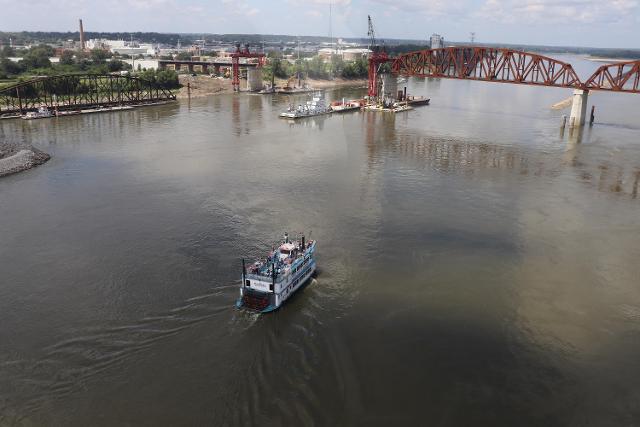ST. LOUIS - The St. Louis region has its advantages - especially for companies looking to ship goods anywhere in the country and beyond. Between the city’s centralized location in the U.S., strategic spot on the Mississippi River, six Class 1 railroads, and four interstate highways, St. Louis continues to invest in its infrastructure as preparations are made for even more freight traffic.
Get The Latest News!
Don't miss our top stories and need-to-know news everyday in your inbox.
Terminal Railroad Association President Brent Wood and Mary Lamie, executive vice president of Multi-Modal Enterprises for the St. Louis Regional Freightway, appeared on an episode of Our Daily Show! on Riverbender.com to discuss the region’s many advantages and multimodal infrastructure.
In St. Louis, the number of manufacturing/logistics employees per mile is about 366, which Lamie said is “one of the higher numbers in the nation.”
“When you compare that to other regions, no one really is within that threshold,” Lamie said. “What that really means is you have a high concentration of workers in those categories, so for companies that are looking to grow in manufacturing and logistics, it really is an ideal location.”
Lamie said the Route 3 Corridor, which spans 60 miles from Alton to Columbia, Ill., is considered a “heavy industry” corridor and provides access to all six of the region’s Class 1 railroads as well as the interstate highway system, and is also in close proximity to the region’s barge industry.
She added that the region is “unique” in having so many geographic and strategic advantages.
“What makes us unique: we have a geographic advantage being in the center of the U.S., a strategic location on the Mississippi River, ice-free, lock-free to the Gulf of Mexico,” Lamie said. “What that means is north of our area, our lock and dams, they act basically like traffic signals and they add additional time.
“What makes us a logistics hub is the fact we have the interconnectivity infrastructure ... you have the harbors like at America’s Central Port in Granite City Harbor, and the fact that it has direct access to the rail, then we have the interstates 255 and 270.
“All of that connectivity gives shippers and carriers optionality - so if something happens with gas prices, or something happens in the transportation industry and freight needs to go from one mode to the other, if you’re coming to the St. Louis area, in a matter of minutes, you can redirect it to another mode of transportation.”
During the pandemic-era supply chain issues, Wood said St. Louis saw a spike in rail traffic. He added that St. Louis is the nation’s second largest rail hub - the first being Chicago - underscoring the importance of infrastructure investment.
“We’ve near doubled the capacity on the Merchants Bridge by rebuilding it in the last 4 or 5 years, so we’re poised and ready for more traffic,” Wood said.
Wood noted that because of St. Louis’s centralized location, it also serves as an “overflow” rail hub which freight can be rerouted to in the event of a Chicago snowstorm or a hurricane in the Gulf of Mexico. Lamie added that St. Louis has “global access” to ports on both the east and west coasts, and its interstate highway system allows toll-free access to the four quadrants of the U.S. with “relatively low congestion.”
Lamie noted they have branded St. Louis as the ‘Ag Coast of America,’ because “nowhere else on the inland waterway system is moving the ag or fertilizer products within a 15-mile section of the river” - a feat that she said has earned the city international media attention.
Several more infrastructure projects and job opportunities are in the works for the near future, Wood said.
“Our Classifying Yard is in Venice and it will run about 2,000 cars a day - 1,000 in and out. This yard expansion, which is about a $70 million project, would add another 1,500 cars of capacity,” Wood said, adding that the project will also alleviate problems like blocked rail crossings. “This Classifying Yard’s a big deal - not just for Terminal, but for the region.
“There will be construction jobs, like there were with the Merchants Bridge. We had 3 or 400 people on site at one point,” Wood said. “The Yard itself, we’re always looking for transportation folks, and you don’t have to have any experience - they’ll teach you what you need to know. Pay rates are outstanding, it’s a union operation, anywhere from $85,000 to $150,000. You have to work overtime, the schedule’s not always what you want it to be, but it’s a good living, it really is.”
Wood added that the job requirements are a high school diploma and a strong work ethic. Other possible job positions range from mechanics, welders, track laborers, locomotive engineers, and more. Lamie noted that training and trade programs are available at Lewis & Clark Community College, Southwestern Community College, and there are apprenticeship programs available across the rail and barge industries.
To find out more about the St. Louis Regional Freighway, visit thefreightway.com. A new Terminal Railroad Association website is currently in development.
The full interview with Wood and Lamie can be watched at the top of this story or on Riverbender.com/video.

More like this:

